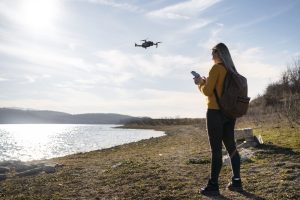The concept of smart cities has evolved in recent years thanks to digitalization and the use of innovative technologies. These cities seek to improve the quality of life of their inhabitants through efficiency, sustainability, and connectivity. Within this framework, the integration of drones into smart cities is emerging as a strategic solution for optimizing mobility, security, logistics, and urban management.
Drones are not just recreational or photography tools. They are becoming a fundamental component of smart urban systems, thanks to their ability to collect information in real time and operate autonomously or semi-autonomously.
What does integrating drones into a smart city mean?
Integrating drones into an urban environment involves coordinating them with existing infrastructure, transportation, and security systems to generate concrete benefits for the city and its inhabitants. Among the main applications are:
- Real-time traffic monitoring: drones can detect congestion and send data to traffic management systems to optimize traffic lights or alternative routes.
- Monitoring of critical infrastructure: bridges, buildings, and roads can be inspected regularly and efficiently.
- Improving public safety: aerial patrols of sensitive areas, rapid response to emergencies, and support for fire and police services.
- Logistics optimization: fast delivery of packages or medicines, especially in areas that are difficult to access.
- Environmental monitoring: air pollution control, noise measurement, and monitoring of green areas.
Benefits of integrating drones into smart cities
- Efficient urban airspace management (UTM): urban air traffic systems coordinate drone fleets, preventing collisions and ensuring the safety of autonomous flights.
- Rapid response to emergencies: immediate deployment capabilities reduce response times to accidents, fires, or critical situations.
- Resource and cost optimization: the use of drones reduces the need for ground vehicles for inspections or deliveries, lowering costs and pollutant emissions.
- Improved urban planning: the data collected allows for the analysis of mobility patterns, energy consumption, and environmental conditions, facilitating evidence-based decisions.
Challenges and considerations for implementation
Although drones offer multiple benefits, their integration into smart cities is not without challenges:
- Urban airspace regulation: clear rules need to be established for commercial and recreational flights.
- Privacy and data protection: Citizens must feel secure in the face of constant drone monitoring.
- Technological infrastructure: Effective implementation requires robust communication networks (5G, IoT) and centralized management systems.
- Professional training: Operators and authorities must receive specialized training to operate and manage drone fleets safely.
Success stories and trends
Cities such as Singapore, Dubai, and Zurich are already exploring the integration of drones for urban inspections, goods transport, and security services. In addition, the trend is toward connected autonomous fleets capable of interacting with ground vehicles and intelligent urban management systems.
The combination of drones, artificial intelligence, and big data will enable urban environments to be more resilient, sustainable, and efficient, driving real digital transformation.
For governments and technology companies, preparing for this change means investing in infrastructure, training, and air management systems that ensure efficiency, safety, and sustainability.
The city of the future is already here, and drones are at the forefront of this transformation.



